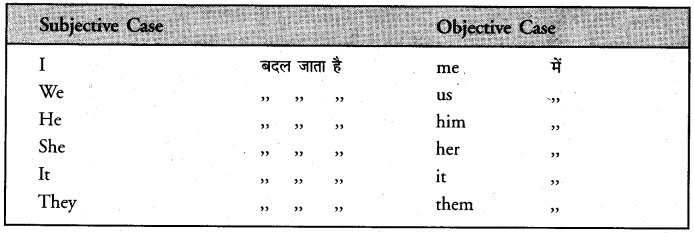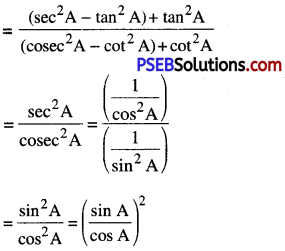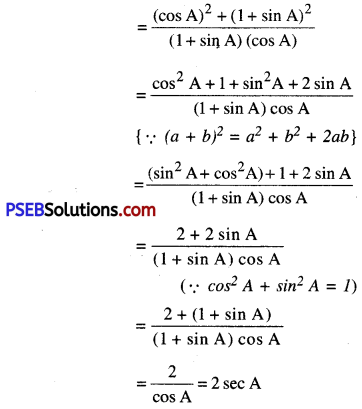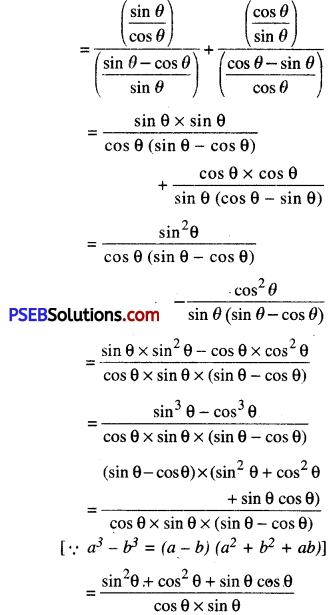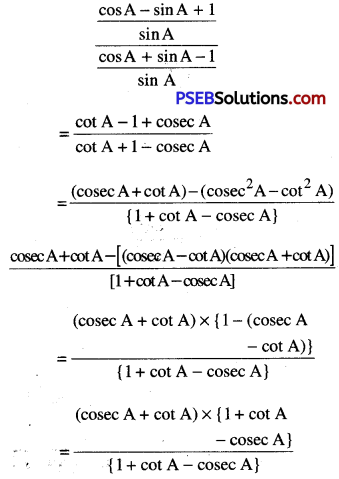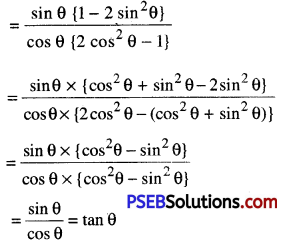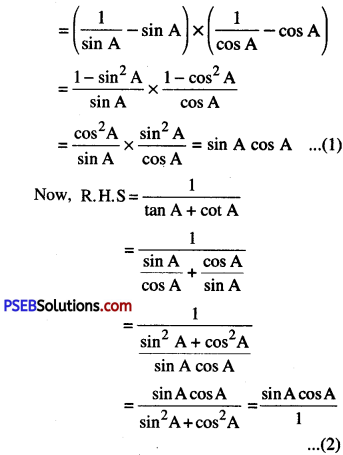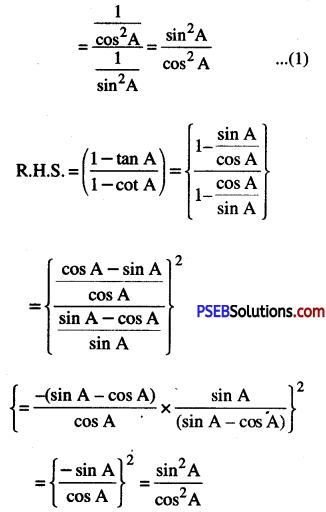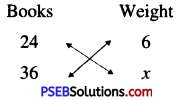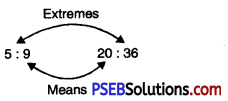Punjab State Board PSEB 8th Class English Book Solutions English Grammar Finite and Non-Finite Verbs Exercise Questions and Answers, Notes.
PSEB 8th Class English Grammar Finite and Non-Finite Verbs
निम्नलिखित वाक्यों को पढ़ो और इन वाक्यों में दिये गए italicised (तिरछे) शब्दों के प्रयोग पर विचार करो-
1. (a) (i) I saw the girls jumping.
(ii). I did not see the dancing girl.
(b) (i) He got his shoes mended.
(ii) He is a worried man now.

2. (i) I went to see the match.
(ii) We go home to take rest.
3. (i) Dancing is an art.
(ii) She enjoys dancing.
सभी italicised शब्द ऐसे शब्द हैं जो अपने आप में किसी वाक्य का Predicate नहीं बन सकते। हम ऊपर दिए गए किसी भी वाक्य का italicised शब्द के साथ predicate नहीं बना सकते। अर्थात् ‘I jumping’, ‘I dancing’ आदि predicate नहीं बना सकते, इस प्रकार के Verbs को Non-Finite Verbs कहते हैं। इसके विपरीत वे Verbs या Verb Phrases जो किसी वाक्य के Predicate बन सकते हैं, Finite Verbs कहलाते हैं।
एक अन्य परिभाषा
Italicised शब्दों पर Tense, Person अथवा Number का कोई प्रभाव दिखाई नहीं देता। अर्थात् जिन Verbs पर Tense, Person के Number का प्रभाव नहीं होता, Non-Finite Verbs कहलाते हैं। Tense अथवा Subject बदलने के पश्चात् भी इन Verbs का रूप नहीं बदलता। इसके विपरीत Finite Verbs का रूप Tense तथा Person के अनुसार बदल सकता है। आओ वाक्यों पर पुनः विचार करें-
1. (a) I saw the train moving.
I see the train moving.
He sees the train moving.
(b) He got his watch repaired.
He gets his watch repaired.
They will get their watches repaired.
2. (i) I want to see the match.
(ii) He wants to see the match.
(iii) We wanted to see the match.
3. (i) She enjoys dancing.
(ii) She will enjoy dancing.
(iii) They enjoyed dancing.
अतः स्पष्ट है कि Finite Verbs (underlined) का परिवर्तन होने पर भी Non-finite Verbs में कोई परिवर्तन नहीं होता।
पूर्ण स्पष्टीकरण
अब दाईं तथा बाईं ओर दिए गए शब्द-समूहों का अध्ययन करो। आप देखेंगे कि Non-finites किस प्रकार Predicate का रूप धारण नहीं कर सकते।
Finite Verbs:
He takes tea.
He can drive well.
They have gone home.
The dog was beaten by the boys
Non-Finite Verbs:
He taking tea.
He to drive well.
They going home.
The dog beaten by the boys.
बाईं ओर के सभी शब्द समूह वाक्य हैं। ऐसा इसलिए है क्योंकि इनके Verbs Predicate का काम करते हैं परन्तु दाईं ओर के Verbs Non-Finites हैं। क्योंकि Non-Finites स्वयं Predicate का निर्माण नहीं करते, इसलिए दाईं ओर के शब्द-समूह वाक्य नहीं हो सकते।
Non-Finites का वर्गीकरण-
(1) Present Participle
(2) Past Participle
1. (a) (i). I saw the girl jumping. (Present Participle)
(ii) I did not see the dancing girl. (Present Participle)
(b) (i) He got his shoes mended. (Past Participle)
(ii) He is a ‘worried man now. (Past Participle)
2. (i) I want to see the match. (Infinitive)
(ii) We go home to take rest. (Infinitive)
3. (i) Dancing is an art. (Gerund)
(ii) She enjoys dancing (Gerund)
I. The Infinitive
I. Infinitive का प्रयोग Noun के रूप में हो सकता है।
1. Verb के Subject के रूप में:
- To forgive is divine.
- To drive a car requires skill.
- To err is human.
2. Object के रूप में:
- She wishes to rise higher in life.
- No one likes to die.
- I want to learn music.
3. Complement के रूप में:
- This house is to let.
- He seems to act well.
- Her desire was to do good.

4. Preposition के Object के रूप में:
- He was about to speak.
- The match was going to start.
- She was about to die.
5. Noun या Pronoun के Apposition के रूप में:
- It is easy to advise others.
- It is bad to find faults with others.
- It is good to help the poor.
II. Infinitive का प्रयोग adjective के रूप में भी हो सकता है।
1. Bere 2017 बताने के लिए
- He got up to ask a question.
- I went to see the Principal.
- He studied to become a doctor.
2. Noun या Pronoun की विशेषता बताने के लिए
- My decision to go is final.
- I have no friends to talk to.
- The topics to be written are known to all.
3. Preposition या Object की विशेषता बताने के लिए
- He is too old to walk.
- She is too young to understand.
- They are too busy to attend the function.
4. verb या complement की विशेषता बताने के लिए
- To tell the truth, I hate shirkers.
- To sum up, he is the best of friends.
- To say in a few words, Mohan achieved the object of his life.
Bare Infinitive या बिना to के Infinitive
इसका प्रयोग होता है:
1. bid, feel, hear, know, let, make, notice, observe, see, watch if Verbs
- I made him give up smoking.
- He bade me open the window.
- I let the boy go.
2. shall, will, would, should, do, have may, must, can, could if Auxiliaries as:
- You may leave now.
- I do not like him.
- You must not disobey your parents.
3. ‘had better’, ‘had rather’, ‘would rather’, ‘had sooner:
- You had better leave this place.
- I would rather starve than beg.
- He would rather solve the problem better.
4. but’, ‘than’s are:
- We could not but laugh.
- He did more than help his friend.
II. The Gerund
The Gerund का निर्माण Verb की पहली फार्म + ing से होता है। Gerund का प्रयोग निम्नलिखित ढंग से हो सकता है।
1. Verb के Subject के रूप में :
- Swimming is a good exercise.
- Speaking is easier than writing.
- Dancing is an art.
2. Verb के Object के रूप में:
- I hate waiting at bus stops.
- He likes reading novels.
- She stopped playing.

3. Preposition के Object के रूप में:
- I am tired of thinking.
- He is thinking of leaving this place.
- He started his journey after resting for an hour.
4. Verb at Complement के रूप में:
- Thinking is doing.
- Talking to him is wasting time.
- Seeing is believing
5. Absolute construction के रूप में:
- Speaking the truth being his habit, we like him.
- Reading the books being his hobby, we appreciate him.
Note : यदि Gerund से पहले कोई noun या pronoun आये तो उसका Possessive रूप ही प्रयोग करना सकता है।
- He stopped my going there.
- He likes my doing this job.
- I do not like Ram’s coming here.
6. Noun Compounds as party के रूप में:
- He bought a new dining table.
- The dancing girl was full of thrill.
- She wastes hours before her looking glass.
Note : निचे कुछ विशेष verbs दिए गए है जिनके साथ Gerund का प्रयोग होता है
- He avoided seeing the Principal.
- He admitted telling a lie.
- She denied using force.
- He dislikes deceiving people.
- I enjoy playing with children.
- He cannot help laughing.
- I don’t mind waiting for an hour.
- I missed seeing that film.
- He postponed his going to Delhi.
- She stopped going there.
- I suggest going for a walk.
III. Participle (Present and Past)
Present Participle : Present Participle का निर्माण verb की पहली फार्म तथा ing से होता है।
Note : Present Participle तथा Gerund दोनों का निर्माण ‘ing’ से होता है; प्रतनु दोनों में अत्नर है (i) Participle adjective के रूप में प्रयोग होता है
उदाहरण:
I like new coat.
I like shining-coat.
यहाँ ‘shining new की तरह adjective का काम कर रहा है। इसलिए यह Participle है।
(ii) Gerund noun के रूप में प्रयुक्त होता है। इसलिए यह वाक्य में वे सभी स्थान ले सकता है जो Noun के होते है; जैसे
Swimming is an exercise. (Subject के रूप में)
I like swimming. (Object के रूप में)
Present Participle का प्रयोग
1. Present Participle का प्रयोग subject के बाद आने वाले Noun के Adjective के रूप में होता है:
- His speech was expressing.
- Her lectures were interesting.
- The results were encouraging.
2. जब दो कार्य एक ही Subject द्वारा एक के बाद एक किए जायें, तो पहले कार्य को व्यक्त करने के लिए Present Participle का प्रयोग किया जाता है, जैसे,
- Seeing his father, the boy ran away.
- She entered, closing the door behind her.
- Crying, she went to qazi.
3. जब दो साथ-साथ हों तो उनमें से एक को Present Participle दुरा यक्त किया जाता है:
- He went into the room singing.
- He came to me running.
- The birds flew away chirping.
4. Present Participle ‘Object complement’ के रूप में भी कार्य कर सकता है:
- We found him studying in his room.
- The doctor found the patient sitting up in bed.
- I saw him watering the plants in his garden.

5. Present Participle का प्रयोग absolutely’ भी होता है; जैसे,
- The weather being fine (having been fine), we decided to go out for a walk.
- The dinner being over, the guests started leaving.
- The song being over, the dancers stopped dancing.
6. कभी- कभी Present Participle का प्रयोग Perfect Participle के रूप में होता है। ऐसा तब किया जाता है जब यह व्यक्त करना हो कि दूसरा कार्य आरम्भ होने से पूर्व पहला कार्य पूरा हो चुका था; जैसे,
- Having seen my sister off, I came home.
- Having done her homework, she went out to play.
- Having seen the film, they went out to a restaurant.
7. Perfect Participle का प्रयोग Passive constructions में भी होता है; जैसे,
- Having been betrayed once, he did not fall into the trap again.
- Having been defeated several times, the army finally surrendered.
- Having been insulted twice, I never went to see him again.
Past Participle : Past Participle verb की तीसरी फार्म होती है।
Past Participle का प्रयोग
Past Participle का प्रयोग निम्नलिखित प्रकार से होता है
1. Adjective के रूप में; जैसे
- His spoken English is much better than his written English.
- The written words have much weight.
- The planned object was achieved.
2. Passive भावना को यकत करने के लिए; जैसे
- The Chief Minister arrived, accompanied by the Minister for Education.
- Shot by an arrow, the bird fell to the ground.
- Disgusted, he left his home.
3. Subject complement के रूप में; जैसे
- They grew tired.
- We were left bored.
- Don’t be disappointed.
4. Object complement के रूप में; जैसे
- I got a new shirt made.
- We got a new home built.
- He had his hair cut.
Combination of Sentences
(Using Non-Finites)
Participle, Infinitive या Gerund (Non-finites) की सहायता से दो वाक्यों को जोड़ कर एक वाक्य भी बनाया जा सकता है।
1. Infinitive के प्रयोग द्वारा
(1) Separate : We go to a cinema. We see a movie.
Combined : We go to a cinema to see a movie.
(2) Separate : The principal called Mrs. Sharma. She would teach English.
Combined : The principal called Mrs. Sharma to teach English.
(3) Separate : I shall go to the market. I shall buy rice.
Combined : I shall go to the market to buy rice.
(4) Separate : She is very poor. She cannot pay her fee.
Combined : She is too poor to pay her fee.
(5) Separate : I want to go to my brother. I shall assist him.
Combined :: I want to go to my brother to assist him.
(6) Separate : I go to the playground. I play there.
Combined : I go to the playground to play.
(7) Separate : I bent. I picked the ball.
Combined : I bent to pick the ball.

2. Participle के प्रयोग द्वारा
(1) Separate : He picked up his umbrella. He went out.
Combined : Picking up his umbrella, he went out.
(2) Separate : The thieves ran away. They saw the policeman.
Combined : Seeing the policeman, the thieves ran away.
(3) Separate : The students stopped talking. They saw the headmaster.
Combined : Seeing the headmaster, the students stopped talking.
(4) Separate : He lost his book. He began to cry.
Combined : Having lost his book, he began to cry.
(5) Separate : He picked the pocket. He ran away.
Combined : Having picked the pocket, he ran away.
(6) Separate : The old lady was helped by the little boy. She was able to cross the road.
Combined : Helped by the little boy, the old lady was able to cross the road.
(7) Separate : I saw some monkeys. They were jumping from branch to branch.
Combined : I saw some monkeys jumping from branch to branch.
(8) Separate : We watched a cricket match. It was being played in our school.
Combined : We watched a cricket match being played in our school.
(9) Separate : I met a girl. She was weeping in the street.
Combined : I met a weeping girl in the street.
(10) Separate : We heard a noise. It was coming from a nearby house.
Combined : We heard a noise coming from a nearby house.
3. Gerund के प्रयोग द्वारा
(1) Separate : Mohan waits for the bus everyday. He can’t bear it.
Combined : Mohan can’t bear waiting for the bus everyday.
(2) Separate : Gopal watches hockey matches. He likes it.
Combined : Gopal likes watching hockey matches.
(3) Separate : Kamla writes stories. She is very fond of it.
Combined : Kamla is very fond of writing stories.
(4) Separate : He helped my brother. I appreciate it.
Combined : I appreciate his helping my brother.
(5) Separate : I avoided Ram. I did not meet him.
Combined : I avoided meeting Ram.

(6) Separate : He was seeing the match. He saw it for some time.
Combined : He went on seeing the match for some time.
(7) Separate : The bird spread the wings. It flew away.
Combined : The bird flew away by spreading the wings.
(8) Separate : You go there. I do not approve of it.
Combined : I do not approve of your going there.
Exercises (Solved) (With Hints) Set-I
Combine the following sentences in each pair using participle:
1. He took aim. He shot the tiger.
2. He hurt his foot. He stopped.
3. He was unwilling to go any further. He returned home.
4. They saw the uselessness of punishment. They changed their way.
5. He was tired of failure. He went to another city.
6. I received no answer. I knocked it second time.
7. He felt tired. He laid his work aside.
8. I went to Delhi last year. I wished to see a doctor.
9. He lost money. He gave up gambling.
10. He gave up the job. He was not satisfied with the salary.
11. He went straight on. He met Ram on the path.
12. A dog stole a piece of meat. He went outside the city to enjoy it.
13. The magician took pity on the mouse. He turned it into a cat.
14. My sister liked the book. She bought it at once.
15. The letter was badly written. I had great difficulty in reading it.
16. The hungry fox saw some grapes. They were hanging from a vine.
17. I was walking along the bank. I saw a dead snake.
18. He ran at top speed. He got out of breath.
19. He jumped up. He ran away.
20. He was tired. He sat down to rest.
21. He finished his dinner. He went out for a walk.
22. He felt sleepy. He went to bed.
23. He aimed at the bird. He shot an arrow.
24. He failed in the examinations. He gave up studies.
25. He ran after the thief. He caught him.
Hints:
1. Taking aim
2. Having hurt
3. Unwilling
4. Seeing the
5. Tired of
6. Having received
7. Feeling tired
8. Wishing to
9. Having lost
10. Dissatisfied with
11. Going
12. Having stolen, the dog went
13. Taking pity, the magician turned
14. Having liked, my sister bought it
15. The letter being badly written.
16. The hungry fox saw some grapes hanging
17. Walking along the bank
18. Running at
19. Jumping up
20. Being tired
21. Having finished
22. Feeling sleepy
23. Aiming at the bird
24. Having failed
25. Running after.

Set-II
Combine the following sentences by using infinitives:
1. I went to the playground. I wanted to see the match.
2. I worked very hard. I wanted to assist him.
3. I want to go to my brother. I want to assist him.
4. I won a scholarship. I had to work very hard for it.
5. She is very poor. She cannot pay her fee.
6. He is very selfish. He will not help you.
7. I shall go to the market. I shall buy sugar.
8. I was trying to lift the box. He helped me.
9. I speak the truth. I am not afraid of it.
10. Everyone should do his duty. The country expects this of everyone.
11. He must apologise to me. This is the only way to escape punishment.
12. I shall succeed. I am sure of it.
13. He will stand first. He is hopeful of it.
14. You will catch the train. You need not run for it.
15. She visits the poor. It is in this way that she can help.
16. He took out the knife. His object was to stab the passer-by.
17. I am very tired. I cannot work.
18. The hunter took up his gun. He wanted to shoot the tiger.
19. He bought a box. He needed it for keeping ornaments in it.
20. The king was very pleased. He heard of the success of his army.
21. This load is very heavy. I cannot lift it.
22. He heard the happy news. He was overjoyed.
23. The problem was difficult. It could not be solved.
24. My friend has gone to Delhi. He will attend a wedding there.
25. This book is very expensive. I cannot buy it.
26. We go to a cinema. We see a movie there.
27. We telephoned the airport. We wanted to ask for some information.
28. The school appointed Miss Sheela. She would teach English.
29. I wanted to meet my parents. I returned home.
30. He wanted to learn the art of bowling. The coach taught him.
31. We bow before our teacher. We respect him.
32. She bought a car. She would travel fast.
33. They use kerosene. They would/will cook their food.
Hints:
1. playground to see
2. hard to assist
3. brother to assist him
4. very hard to win a scholarship
5. too poor to pay her fees
6. too selfish to help
7. market to buy
8. He helped me lift
9. afraid to speak the truth
10. expects everyone of us to do our duty
11. to escape punishment
12. sure to succeed
13. he hopes to stand
14. run to catch
15. She visits the poor to help them
16. knife to stab
17. too-to
18. his gun to shoot
19. a box to keep
20. pleased to hear
21. too heavy for me to
22. overjoyed to hear
23. too difficult to be
24. gone to Delhi to attend
25. too expensive for me to
26. to a cinema to see
27. the airport to ask
28. appointed Miss Sheela to teach
29. home to meet
30. taught him to learn
31. our teacher to respect
32. a car to travel fast
33. use kerosene to cook
Exercises From Board’s Grammar (Solved)
1. Pick out Infinitives in the following sentences:
1. To lie is a sin.
2. I saw him enter.
3. She let me watch the film.
4. He promised to come.
5. To forgive is divine.
6. He is too weak to walk.
7. I don’t know where to go.
8. It is shameful to cheat your friend.
9. I watched her dance.
10. Straw is used to make paperboard.
Answer:
1. To lie
2. enter
3. watch
4. to come
5. To forgive
6. to walk
7. to go
8. to cheat
9. dance
10. to make.

II. Complete the following sentences by filling in the blank spaces with appropriate non-finite forms:
1. (Err) is human, (forgive) is divine.
2. You ought (get) up earlier.
3. It is easy (make) mistakes.
4. Why not (take) the day off?
5. He made me (repeat) the lessons.
6. You needn’t (say) anything.
7. I am sorry (disappoint) you.
8. He heard a cock (crow) in the neighbouring village.
9. Would you (like) (come) in my car?
10. He will be able (swim) very soon.
Answer:
1. To err, to forgive.
2. to get
3. to make
4. take.
5. repeat
6. say
7. to disappoint
8. crow.
9. like, to come.
10. to swim.
III. Combine the following pairs of sentences into one sentence each using too / enough + infinitive:
1. You are very young. You can’t have a gun.
2. He is very ill. He can’t eat anything.
3. The coffee is strong. It won’t keep us awake.
4. Tom was very foolish. He told lies to the police.
5. He was furious. He couldn’t speak.
6. You are quite thin. You could slip between the bars.
7. It is very cold. We can’t bathe.
8. It is very cold. We can’t go out.
9. The fire isn’t very hot. It won’t boil water in a kettle.
10. I am rather old. I can’t walk that far.
Answer:
1. You are too young to have a gun.
2. He is too ill to eat anything.
3. The coffee is not strong enough to keep us awake.
4. Tom was foolish enough to tell lies to the police.
5. He was too furious to speak.
6. You are thin enough to slip between the bars.
7. It is too cold for us to bathe.
8. It is too cold for us to go out.
9. The fire isn’t hot enough to boil water in a kettle.
10. I am too old to walk that far.
IV. Pick out gerunds in the following sentences:
1. Gambling is a bad habit.
2. She enjoys sleeping.
3. Old men enjoy gossiping.
4. I hate waiting.
5. Stealing is a crime.
6. He is fond of walking.
7. I am good at spelling.
8. We took part in boating.
9. My sister does not like cooking.
10. She is fond of dancing.
Answer:
1. Gambling.
2. sleeping.
3. gossiping.
4. waiting.
5. stealing
6. walking
7. spelling
8. boating.
9. cooking
10. dancing.
![]()
![]()
![]()

